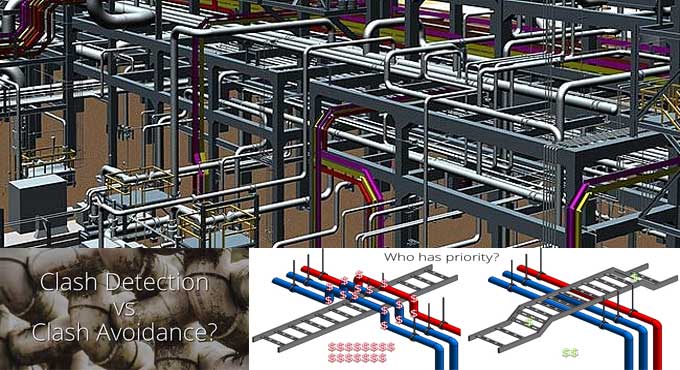
Clash Detection vs. Clash Avoidance: Meaning and Differences

What do you mean by clash detection?
Clash detection is the process of identifying potential conflicts or clashes between different components or systems in a construction project. It is typically used in the context of building information modeling (BIM), where clash detection software is used to scan 3D models of a building or infrastructure project to identify any clashes or interference between different elements such as mechanical, electrical, plumbing, or structural components.
BIM software allows designers and engineers to create a virtual model of the building, which can be used to detect clashes between different elements. Clash detection software analyses the model and identifies any conflicts between elements, highlighting them in a 3D view.
Once clashes are identified, designers can modify the model to resolve the conflicts. For example, they may adjust the position or size of an element to avoid overlapping with another. Clash detection helps to prevent construction errors and reduces the likelihood of rework or delays during the construction process.
Clash detection can also be used to detect clashes between the virtual model and real-world conditions, such as site constraints or existing structures. This helps to ensure that the design is feasible and can be constructed as planned.
What do you mean by Clash Avoidance?
Clash avoidance refers to the process of designing a construction project in a way that minimizes or eliminates clashes between different components or systems. It involves careful planning, coordination, and communication among different stakeholders involved in the project, such as architects, engineers, contractors, and subcontractors.
The goal of clash avoidance is to identify and resolve potential clashes or interference between different elements of the project before construction begins. This can be achieved through the use of clash detection software, which scans 3D models of the project to identify any conflicts. Once potential clashes are identified, the design team can make adjustments to the design or modify the placement of components to avoid conflicts.
Clash avoidance can help to prevent costly rework, delays, and disruptions during construction, and can ultimately lead to a more efficient and cost-effective project delivery. It also helps to improve the quality and safety of the project, by ensuring that all components are properly integrated and installed in a way that meets the project specifications and requirements.
When Clash detection is made, what happens?
After performing clash detection in Building Information Modeling (BIM), the next steps would depend on the specific project and the issues that have been identified.The following steps are generally followed:
1. Review the clashes: The first step after detecting clashes is to review them to determine the root cause of the problem and develop a plan to address them.
2. Prioritize the clashes: Once the clashes have been reviewed, they are typically prioritized based on their severity and impact on the project schedule and budget.
3. Resolve the clashes: The next step is to resolve the clashes, which may involve making changes to the design or construction plan, coordinating with other stakeholders, or adjusting the project schedule.
4. Update the BIM model: After the clashes have been resolved, the BIM model is updated to reflect the changes that were made.
5. Verify the resolution: Once the BIM model has been updated, the clashes should be re-checked to ensure that they have been fully resolved.
6. Document the resolution: Finally, the resolution of the clashes should be documented for future reference and to assist with ongoing project management.
Differences between Clash Detection and Clash Avoidance
Clash detection and clash avoidance are two different processes used in construction and design projects.
Clash detection is a process that identifies clashes or conflicts between different elements in a design model, such as clashes between mechanical, electrical, and plumbing (MEP) systems or structural elements.
Clash detection typically involves using software tools to analyze the 3D models of various building systems and detect any interferences or collisions. The purpose of clash detection is to identify and resolve design conflicts before construction begins, which can save time, reduce costs, and minimize risks.
Clash avoidance, on the other hand, is the process of preventing clashes from occurring in the first place. This can be achieved by coordinating the design of different systems and elements during the planning phase, using best practices, such as modular design, standardization, and prefabrication, to minimize the chances of interferences.
To learn more, watch the following video tutorial.
Video Source: Brett Young
Clash avoidance also involves using efficient communication and collaboration tools to ensure that different teams are working together effectively and sharing information in real-time.
Final Thoughts
The technique of clash detection identifies clashes after they have occurred, whereas clash avoidance prevents clashes from occurring in the first place. It is crucial that both processes are followed in order to ensure that construction projects are completed on time, within budget, and to the required quality level.


